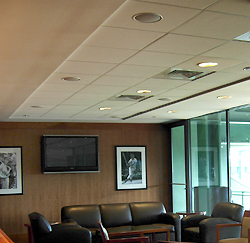
Equalization
Setting EQ for ceiling loudspeakers can be different than with sound reinforcement loudspeakers.
Incorrect measurement techniques will result in the system not sounding very good.
It would be a shame to design and install a great system and then misadjust the EQ so it sounds like an amateur job.
An example of poor measuring technique is positioning the measurement mic in the overlap region between adjacent loudspeakers. This can lead to faulty measurements.
Microphones tend to show signal additions and cancellations at various frequencies that only occur in that 1-inch space where the microphone is placed and may not be representative of the listening space as a whole.
More than a few installers have tried to equalize for floor reflections, which sometimes results in large boosts and cuts in adjacent EQ filter bands. You can not equalize out floor reflections (or any other reflections). For good, solid measurements, some suggestions follow here.
Mic Placement Within the Loudspeaker Coverage Pattern. Place the microphone either on-axis or up to 20 degrees off-axis. Try to stay within the coverage pattern of a single loudspeaker. When equalizing on-axis, you are equalizing the direct sound in the mid to high frequencies, whereas at low frequencies, you’re still taking into account the low-frequency summation of adjacent loudspeakers.
Microphone Height. While it seems like it would be best to place the microphone at the typical listening height for the application, the measurements can be contaminated by floor reflections that can artificially add or subtract to various frequencies as displayed on your test equipment.
For example, a measurement taken at a 4-foot (1.2-meter) height may show dips at odd multiples of 80 Hz (240 Hz, 400 Hz, 560 Hz, 720 Hz, 880 Hz, etc.) and peaks at even multiples of 80 Hz (160 Hz, 320 Hz, 480 Hz, 640 Hz, etc.).
Depending on the resolution and bandwidth characteristics of your measuring device, these can show up as various boosts and dips in your measurement bands. These reflections are not equalizable, and trying to equalize them out can result in a very bad sounding system. It is best to eliminate floor reflections from your measurement. How do you do that?
Eliminating Floor Reflections by Mic Positioning. To eliminate the floor reflection from your measurements, use the microphone in pressure zone mic mode by placing the mic on a hard surface on the ground or by setting it on a large piece of plywood at ear height.
For this type of measurement, the microphone is typically laid on its side. If you’re using plywood, place the mic slightly off center on the plywood to minimize complications from the addition of symmetrical diffraction effects from the edges of the plywood plane. Placement about 4 to 6 inches away from the center point, toward one of the corners, is appropriate.
To maximize the high frequency accuracy, make sure that the microphone diaphragm is as close to the plywood plane (or floor) surface as possible. If the natural contour of the mic case makes the element sit off the surface, it is beneficial to angle the case so the mic diaphragm is within 1/4-inch (6 mm) of the wood surface, without actually touching the wood (or floor).
You may get some strange looks by placing your microphone on the floor, but it’s the best way to get an accurate measurement. Anyway, funny looks during the testing phase sure beat funny looks after the system is up and running.
Microphone Type. If possible, use an instrumentation-grade microphone.
To get the most accurate measurement in PZM mode, a small-diaphragm mic with small housing is best because it allows the mic diaphragm to get as close as possible to the plywood (or floor), minimizing any interference between direct waves and those reflected back onto the diaphragm from the plywood itself and thereby minimizing false information.
Your curve is only going to be as good as the measurement mic you’re using, so if at all possible, use an accurate, top-quality instrumentation mic.
